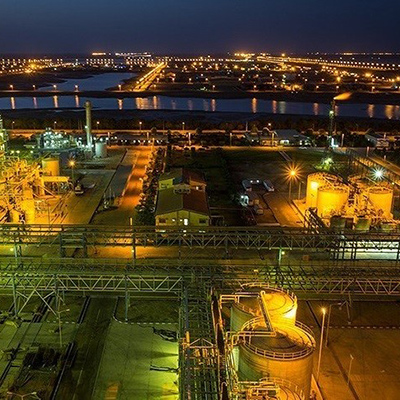Sites
Mahshahr Port
Maryam Latifi
212 دورہ
Located in Khuzestan Province at the northeastern tip of Khor Mousa, the port of Bandar-e Mahshahr served as a specialized export hub during the Iran–Iraq War, actively supporting domestic fuel distribution and the import of essential goods. Mahshahr Port comprises two areas: the old town and the new district, situated about 3 kilometers apart. Most of the city’s residents live in the older area, which has a more traditional layout and hosts most government offices. The primary occupations of the people include agriculture, fishing, and handicrafts. The population is predominantly Shiite, and the local languages are Persian and Arabic. Mahshahr has a hot and humid climate. Due to its saline and alkaline soil conditions, vegetation in the area is sparse, consisting mainly of scattered konar and gaz trees. According to the 2016 national census, the population of Mahshahr County was 296271.[1]
The historical background of Mahshahr Port—previously known as Majul and Mashour—dates back to the late 13th century.[2] Not until the late Qajar era did the port gain any significance; it had previously been merely a small harbor from which local ships transported imports and exports to neighboring Arab tribes. With the construction of the Trans-Iranian Railway and the establishment and expansion of Shahpur Port, Mashour also began to flourish. Over time, this port attracted attention as a crude oil export hub and gradually developed with the installation of pipelines and oil storage tanks. Pipelines transported oil from Aghajari to the Abadan refinery and then to Mashour.[3]
The first pier built by the Anglo-Iranian Oil Company in Mashour was Khour-Ghazaleh. Subsequently, the port underwent expansion and was equipped with the necessary infrastructure to accommodate large vessels.[4] Crude oil exports from this port began in 1945.[5]
In 1954, the oil consortium agreement was signed between the National Iranian Oil Company and eight major oil companies. During the implementation of this agreement, a project known as “Chem” was executed between 1963 and 1967 to develop operating oil companies in Iran.[6] Following the Chem project, beginning in 1967, crude oil extracted from the contract areas was exported to global markets via Khark Island in the Persian Gulf. Meanwhile, Mashour Port was designated for the export of refined petroleum products produced at the Abadan refinery. These included gasoline, premium gasoline, kerosene, aviation fuel, diesel, liquefied gas, light and heavy naphtha, paraffin, acid, lubricants, bitumen, and fuel oil.
As part of this development, 32 new storage tanks were added to the coastal tank farm. Moreover, the port was equipped to accommodate heavy vessels and ocean-going tankers of up to 50000 tons, alongside the construction of a natural gas refinery.[7]
In 1965, the Iranian government officially renamed Mashour to Mahshahr.[8]
With the outbreak of the Iran–Iraq War and the closure of the Abadan refinery in the initial days of the conflict, Mahshahr Port—formerly the principal export terminal for refined petroleum products from Abadan—ceased operations in this capacity.[9] Despite oil production continuing at other refineries, the country faced a severe shortage of petroleum products and had to rely on imports to meet domestic demand. Mahshahr Port, therefore, became a major entry point for imported petroleum products, some of which were delivered via the floating terminal at the Behregan oil field—known as the SPM—and transported through pipelines to Mahshahr. Throughout the war, Mahshahr played a critical role in supplying domestic fuel and importing essential goods.[10]
One of Iraq’s principal strategies for disrupting Mahshahr Port’s operations was to target commercial vessels transiting through the Khor Mousa waterway and to bomb the port’s facilities directly. On October 17, 1980, Iraqi aircraft attacked Mahshahr Port, causing significant damage to its facilities and fuel storage depots.[11] On May 9, 1982, six commercial vessels carrying food supplies and military equipment en route to Mahshahr were struck by Iraqi air-launched missiles.[12] On August 9, 1982, the Greek-owned tankers Liston Braid and Bonosambo—the latter under charter by South Korea—were attacked by Iraqi helicopters shortly after unloading their cargo at Mahshahr Port, and Liston Bride sank as a result.[13] On September 4, 1982, a Turkish vessel headed for Mahshahr was similarly attacked by Iraq and sunk.[14]
In response to escalating Iraqi aerial and naval attacks, the Iranian military command in 1983 implemented a convoy policy to safeguard maritime traffic along key export routes in the northern Persian Gulf. Accordingly, ships traveling between Bushehr, Bandar Imam Khomeini (ra), and Mahshahr would sail about every 10 to 20 days based on how many were involved. Iranian Air Force fighter jets, Army Aviation (Havanirooz) and Oil Company helicopters, Iranian Navy missile boats, armed speedboats, and Islamic Revolutionary Guard Corps (IRGC) tugboats would escort the ships to protect them and ensure their safety.[15]
Despite these measures, Iraq often found out about the movement timings of convoys and managed to carry out attacks. Although the Iranian air-defense systems provided limited protection, but in many cases, several vessels in a convoy would be hit by Iraqi rockets.[16] For instance, on September 12, 1983, Iraq launched an airstrike on a convoy of forty ships headed for Mahshahr Port.[17]
Iraqi air raids on Mahshahr Port’s facilities continued until the final days of the war. On March 16, 1988, Iraqi aircraft struck Mahshahr Port, damaging Majidiyeh Pier, storage tanks for gasoline and diesel, and gas pipelines.[18]
Beyond its maritime role, Mahshahr functioned as a crucial logistics hub for front-line resupply. During the siege of Abadan, for example, fuel was shipped from Mahshahr to Chavibdeh using flat barges that were tied to traditional wooden boats.[19] In Operation Valfajr 8, Mahshahr served as a major rear-supply base for Iranian forces.[20]
After the war, with security restored in Khor Mousa and the reconstruction and reopening of the Abadan refinery, Mahshahr Port resumed exporting the petroleum products. In 2006, a comprehensive development plan for Mahshahr’s export terminal—covering modernization of onshore and offshore facilities—was introduced. The project began in 2007 and had reached 80 percent completion by 2019. Between 2019 and 2020, the most critical upgrade was implemented, doubling the terminal’s berthing and transfer capacity. As a result, Mahshahr’s export terminal tripled its throughput capacity for petroleum products.[21]
Today, the port operates with 90 storage tanks, 8 berths for loading petroleum products and goods, 11 active pumping stations, 5 furnaces, and the capability to handle more than 10 types of petroleum products. It ranks among the world’s major export hubs for refined petroleum products, capable of accommodating tankers with capacities ranging from 30000 to 100000 tons. In addition to handling exports to domestic and international ports, Mahshahr Port’s facilities also supply feedstock to the aromatics unit of the Bandar Imam Petrochemical Company.[22]
In 2022, the first volume of the book “Memoirs of the Martyrs of Mahshahr Port” by Adel Shirali and his wife, Narges Shah-Muhammadi was published. The book draws upon the memories of Martyr Commander Mahmoud Raees Qanavati, who served as the commander of the Mahshahr Shuhada Battalion.[23]
[1] Sit-e Shahrdari Bandar-e Mahshahr (Mahshahr Port Municipality Website), https://mahshahr.ir/
[2] Qayyem, Bahador, Tarikh-e Hashtad Saale Bandar-e Imam Khomeini (The Eighty-Year History of Imam Khomeini (ra) Port), Isfahan, Homay Rahmat, 1388, Pp. 133, 149, 66.
[3] Daneshnamei-e Jahan Eslam (Encyclopedia of the Islamic World), Vol. 4, Tehran, Bonyad-e Dayerat al-Maaref-e Eslami, 1377, Madkhal: Bandar-e Mahshahr.
[4] Qayyem, Bahador, Marakez-e Eqtesadi-ye Khuzestan dar Jang (Economic Centers of Khuzestan during the War), Tehran, Markaz-e Asnad va Tahqiqat-e Defa Muqaddas-e Sepah-e Pasdaran-e Enqelab-e Eslami, 1397, p. 90.
[5] Daneshnamei-e Jahan Eslam (Encyclopedia of the Islamic World), Ibid.
[6] Labatfar, Ahmad, Ejra-ye Tarh-e Chem va Tasirate An dar Sanat-e Naft-e Iran (Implementation of the Chem Plan and Its Effects on Iran’s Oil Industry), Pajouheshnameh-ye Tarikh-e Ejtemaei va Eqtesadi, No. 2, Fall and Winter 1398, Pp. 241, 242, 249.
[7] Qayyem, Bahador, Ibid., Pp. 90-93, 94.
[8] Daneshnamei-e Jahan Eslam (Encyclopedia of the Islamic World), Ibid.
[9] Daneshnamei-e Jahan Eslam (Encyclopedia of the Islamic World), Vol. 5, Tehran, Bonyad-e Dayerat al-Maaref-e Eslami, 1379, Madkhal: Palayeshgah-e Abadan.
[10] Ansari, Mahdi & Mahmoud Yazdanfam, Jang-e Mahdud-e Iran va Amrika dar Khalij-e Fars (The Limited War between Iran and America in the Persian Gulf), Tehran, Markaz-e Asnad Defa Muqaddas-e Sepah-e Pasdaran-e Enqelab-e Eslami, 1387, p. 410; Lotfollahzadegan, Ali-Reza, Amaliat-e Valfajr 1 (Operation Valfajr 1), Tehran, Markaz-e Asnad Defa Muqaddas-e Sepah-e Pasdaran-e Enqelab-e Eslami, 1394, Pp. 284, 746.
[11] Ansari, Mahdi & Hussain Yekta, Hojoom-e Sarasi (The All-Out Attack), Tehran, Markaz Motaleat va Tahqiqat Jang Sepah-e Pasdaran-e Enqelab-e Eslami, 2nd ed., 1375, p. 455.
[12] Lotfollahzadegan, Ali-Reza, Ibid., p. 284.
[13] Lotfollahzadegan, Ali-Reza, Obur az Marz - Taghib-e Motajavez ba Amaliat-e Ramazan (Crossing the Border – Pursuing the Aggressor with Operation Ramazan), Tehran, Markaz Motaleat va Tahqiqat Jang Sepah-e Pasdaran-e Enqelab-e Eslami, 1381, p. 575.
[14] Lotfollahzadegan, Ali-Reza, Amaliat-e Moslem ibn Aqil – Azadi-ye Ertefaat-e Sumar va Tahdid-e Mandali... (Operation Moslem ibn Aqil – Liberation of Sumar Heights and Threat to Mandali...), Tehran, Markaz-e Asnad va Tahqiqat-e Defa Muqaddas-e Sepah-e Pasdaran-e Enqelab-e Eslami, 1391, p. 203.
[15] Lotfollahzadegan, Ali-Reza & Iraj Hemmati, Nokhostin Amaliat-e Bozorg dar Shomal-e Gharb – Valfajr 4 (The First Major Operation in the Northwest – Valfajr 4), Tehran, Markaz-e Asnad va Tahqiqat-e Defa Muqaddas-e Sepah-e Pasdaran-e Enqelab-e Eslami, 1397, Pp. 39-40.
[16] Nemati, Yaqoub & Digaran, Amadeh Sazi-ye Amaliat-e Valfajr 4 - Tajhiz-e Araq be Jangandehaye Super Standard... (Preparation for Operation Valfajr 4 – Iraqi Army is Equipped with Super-Standard Fighters...), Tehran, Markaz-e Asnad va Tahqiqat-e Defa Muqaddas-e Sepah-e Pasdaran-e Enqelab-e Eslami, 1394, p. 426.
[17] Hashemi, Mahdi, Aramesh va Chalesh – Karnameh va Khaterat-e Hashemi Rafsanjani Sal 1362 (Calm and Challenge – The Record and Memoirs of Hashemi Rafsanjani in 1983), Tehran, Daftar-e Nashr-e Maaref-e Enqelab, 1381, p. 268; Nemati, Yaqoub & Digaran, Ibid., p. 426.
[18] Izadi, Yadollah, Amaliat-e Valfajr 10 (Operation Valfajr 10), Tehran, Markaz-e Asnad va Tahqiqat-e Defa Muqaddas-e Sepah-e Pasdaran-e Enqelab-e Eslami, 1392, p. 186.
[19] Qayyem, Bahador, Marakez-e Eqtesadi-ye Khuzestan dar Jang (Economic Centers of Khuzestan during the War), p. 392.
[20] Ansari, Mahdi & Hamid-Reza Farahani, Tashdid-e Talash-ha baraye Fath-e Faw (Intensification of Efforts to Capture Faw), Tehran, Markaz-e Asnad va Tahqiqat-e Defa Muqaddas-e Sepah-e Pasdaran-e Enqelab-e Eslami, 1395, p. 676.
[21] https://www.tasnimnews.com/fa/news/1400/04/18/2535220; Roozname-ye Resalat (Resalat Newspaper), No. 6238, 17/6/1386, p. 6; Roozname-ye Iran (Iran Newspaper), No. 4366, 27/8/1388, p. 19.
[22] Sit-e Palayeshgah-e Abadan (Abadan Oil Refinery Company Website), https://www.abadan-ref.ir/fa/content
[23] Sit-e Khabargozari Ketab-e Iran (Iran Book News Agency Website), Code: 322443.





